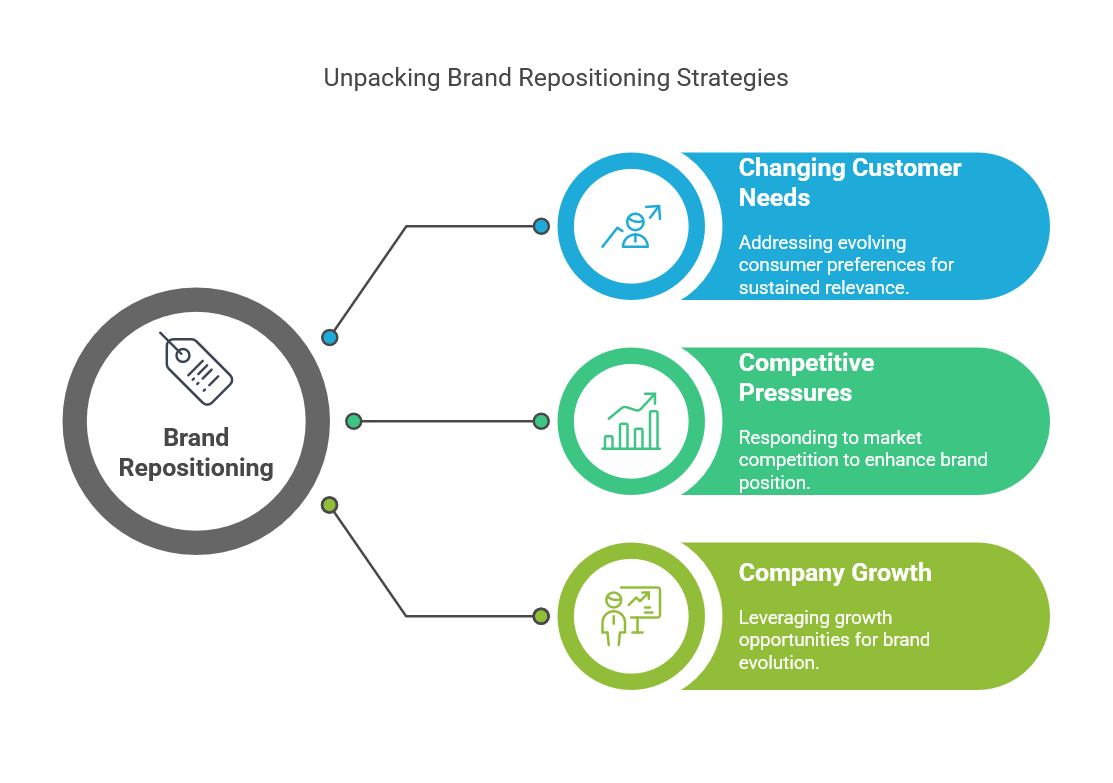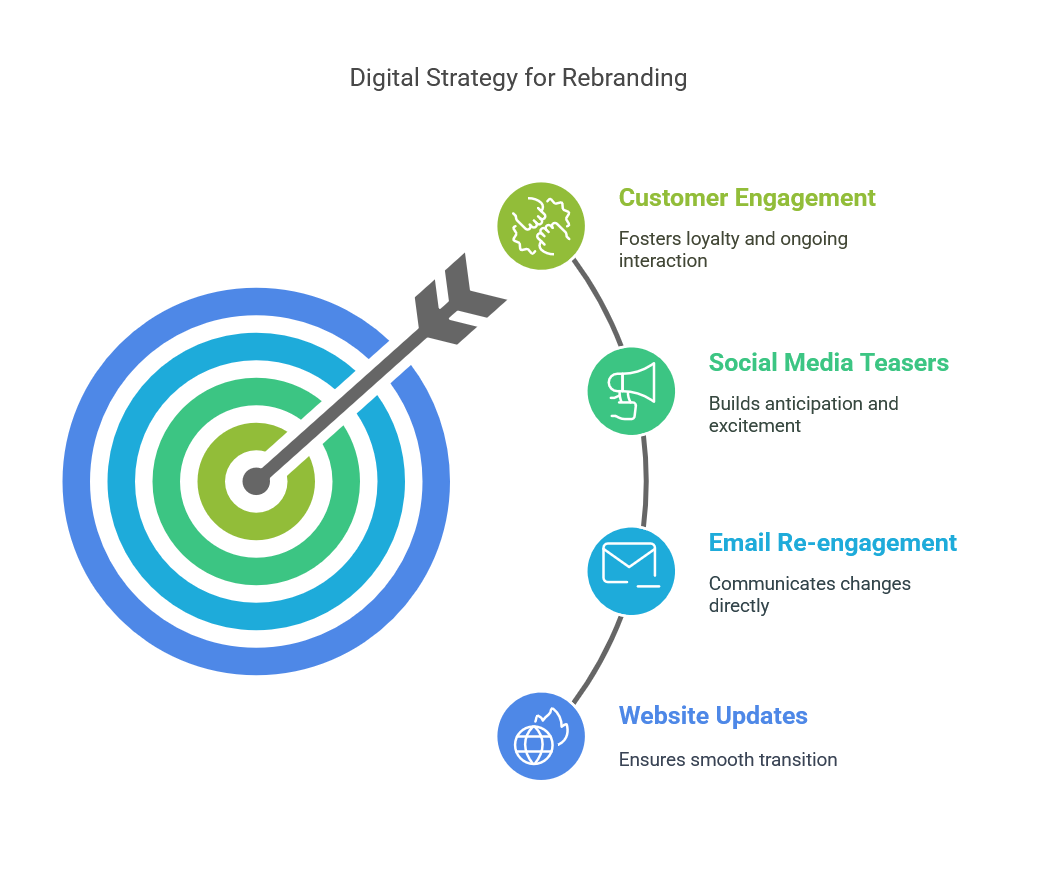
Strategic Brand Repositioning: A Roadmap for Evolving Your Identity in a Changing Market
Table of Contents
As market landscapes shift, businesses occasionally need to reposition or reinvent their brand online—updating visuals, refining brand voice, or pivoting business models. This advanced guide offers organisations a roadmap to strategic brand repositioning, covering archetype alignment, content strategies, design refreshes, and customer-centric transformations that prevent audience confusion.
Why Brands Reposition

In today’s fast-paced market, brands must evolve to stay relevant. Whether driven by changing customer needs, competitive pressures, or company growth, repositioning allows businesses to refresh their identity and strengthen their market presence. Understanding the key reasons behind a brand’s decision to reposition is crucial for navigating the process successfully and ensuring long-term success.
Evolving Customer Needs
A brand initially selling in-person training may pivot to digital courses, prompting rebranding of the site, user flows, or brand story. This adaptation ensures the business remains relevant as customer preferences shift toward digital consumption.
Competitive Pressure
If new entrants overshadow an established brand’s identity, repositioning helps reclaim relevance and differentiation in the marketplace. This proactive approach prevents competitors from dictating how customers perceive your industry.
Company Growth
SMEs crossing into new markets (like going from local Northern Ireland clientele to UK-wide distribution) might adopt more professional or universal brand aesthetics. This evolution ensures the brand resonates with broader audiences while maintaining core values.
A 2023 rebranding insights report found that 65% of businesses rebrand within 7–10 years, often in response to significant strategic shifts. This statistic highlights how brand repositioning is a natural part of business evolution rather than an indication of failure.
Brand Identity Audits: Evaluate Your Old Site, User Perception, Competitor Benchmarks
Before adopting a fresh identity, businesses must conduct thorough audits of their current brand position:
Visual Consistency
Assess whether the logo, colour palette, or typography reflect current values. Are stakeholders noticing that brand elements appear dated or inconsistent across channels? This evaluation often reveals opportunities for modernisation while preserving brand equity.
Customer Surveys
Companies can ask loyal customers about brand associations. If research uncovers confusion or outdated perceptions, that’s a strong signal for repositioning. Questions might include:
- What three words would you use to describe our brand?
- What do you think our primary offerings are?
- How would you compare us to competitors?
Competitor Analysis
Examine how rivals brand themselves, such as with minimal aesthetics, edgy fonts, or modern imagery. By identifying gaps in the competitive landscape, businesses can glean insights for distinct positioning.
A brand refresh doesn’t mean discarding everything,” says Ciaran Connolly, Director of ProfileTree. It’s about distilling what resonates, evolving for new directions, and telling customers, ‘We’ve listened and adapted.’ An authentic story helps audiences embrace the transformation rather than fear it.
Mapping Brand Archetypes or Brand Voice Realignment
Archetypes—like “The Explorer,” “The Sage,” or “The Caregiver”—help companies define brand personality in customer communications, visuals, or content. Realigning brand voice involves several key considerations:
Tone
Is your organisation adopting a warmer, friendlier tone versus a once-formal approach? This shift should align with your target audience’s expectations and communication preferences.
Language
Consider changing “We do X” to “Your success is our priority.” This customer-centric language creates stronger connections and demonstrates empathy for audience needs.
Emotional Triggers
Brands emphasise different emotional responses—adventure, security, or creativity—depending on their chosen archetype. These emotional elements should consistently appear across all touchpoints.
A 2024 brand archetype usage poll indicated that businesses with consistent archetype branding experience 20–30% higher customer recall. This improved memorability translates into more substantial brand recognition and loyalty.
Digital Channels for Rebranding Rollout

Leveraging digital channels is essential for effectively reaching and engaging your audience when rebranding. From social media teasers to email re-engagement and website updates, strategically using these platforms helps build anticipation, communicate your brand’s evolution, and ensure a smooth transition. A well-executed digital rollout informs and excites customers about the changes, fostering loyalty and ongoing engagement.
Social Teasers
Businesses can drop subtle hints about “a fresh chapter” or “something new,” building anticipation before a big site reveal. This approach creates curiosity and prepares audiences for upcoming changes.
Website “Coming Soon” Placeholders
A preview page can generate audience curiosity if undergoing a major site redesign or rebrand. These pages might include:
- Countdown timers to launch
- Email signup for notification
- Sneak peeks of new visual elements
- Brief explanation of the upcoming changes
Email Re-Engagement
Companies can re-introduce themselves with messaging like: “Our brand is evolving—here’s why it benefits you.” Links to a short brand story or behind-the-scenes blog provide context and rationale for the change.
Offline Alignments
Update business cards, brochures, signage, and other physical materials to ensure consistency with the new digital identity. This unified approach prevents confusion across touchpoints.
Minimising Customer Confusion: Consistent Messaging, Disclaimers, or Q&A
A successful rebrand demands careful communication strategies:
Explain the “Why”
Customers appreciate sincerity: “We grew from local to nationwide, and it’s time our brand reflects the expanded vision.” This transparency builds trust during the transition.
Keep Key Elements
Consider retaining specific brand colours or a symbolic logo motif to anchor customers connected with the old identity. These familiar elements create continuity amid change.
Offer a Q&A or Blog Post
Customers who ask, “Will your product lines or prices change?” can find immediate answers, removing uncertainty. Addressing common concerns proactively prevents speculation and rumours.
Stat: A 2023 brand revamp survey revealed that 62% of businesses that thoroughly communicated rebrand reasons experienced minimal customer drop-off or confusion. This finding underscores the importance of transparent communication during brand transitions.
The Role of AI and Personalisation
AI and personalisation play a pivotal role in modern brand repositioning by enabling businesses to tailor their messaging and content to specific customer segments. AI can help refine the brand voice, optimise user experiences, and predict customer preferences through data analysis and real-time insights, ensuring a more targeted and effective rebrand. Embracing these technologies allows brands to engage customers more meaningfully, enhancing their repositioning efforts‘ impact and success.
Content Overhaul
AI-based text rewriting tools enable businesses to unify brand voice across site pages efficiently. These tools can identify inconsistent messaging and suggest alternatives that align with the new brand guidelines.
Dynamic Personalisation
Companies can introduce new brand elements or messaging specifically to frequent customers first, gathering real-time feedback. This segmented approach allows for refinement before a broader rollout.
Predictive Insights
If a company is planning to pivot toward specific products or services, AI usage data can confirm which customer segments might respond best. These insights help prioritize marketing efforts during the repositioning.
Stats and Frameworks
- 65% of brands rebrand within a 7–10 year cycle (Rebranding Insights, 2023).
- Using brand archetypes consistently yields a 20–30% higher customer recall (Brand Archetype Usage Poll, 2024).
- Businesses with thorough rebrand communications faced minimal customer confusion (62% success rate in Brand Revamp Survey, 2023).
- Companies that maintain some visual continuity during rebrands retain 28% more brand equity than those making complete changes (Brand Equity Study, 2023).
Comprehensive Rebrand Framework:
1. Audit
- Assess current brand perception through customer research
- Evaluate the competitive landscape and positioning
- Identify strengths to preserve and weaknesses to address
- Analyze performance metrics across channels
2. Plan
- Define new archetype and brand personality
- Develop refreshed brand voice guidelines
- Create updated visual identity systems
- Establish a timeline for phased implementation
3. Pre-Launch Teasers
- Deploy social media hints about upcoming changes
- Send email notifications to prepare the customer base
- Brief internal teams to ensure consistent messaging
- Create anticipation through strategic content
4. Big Reveal
- Launch a redesigned website or refreshed digital presence
- Announce changes across all channels simultaneously
- Provide a clear explanation for the repositioning
- Highlight benefits to customers and stakeholders
5. Monitor & Iterate
- Track customer feedback across channels
- Measure engagement metrics pre and post-rebrand
- Refine any elements causing friction or confusion
- Continue reinforcing new brand positioning in communications
Embracing Brand Evolution for Ongoing Relevance
A brand is never static; it evolves as a company’s offerings, markets, or customer expectations change. Organisations ensure their audience feels part of the journey rather than left behind by auditing the old identity, carefully mapping a new voice or archetype, and rolling out changes with transparent messaging. This inclusive approach transforms brand reinvention from a risky gamble to a strategic path toward renewed customer enthusiasm and loyalty.
Building on Brand Heritage
Successful repositioning acknowledges brand history while embracing future direction. Companies should:
- Identify which brand elements carry positive equity
- Determine which aspects of brand history to highlight
- Create narratives that connect past achievements to future vision
- Frame the rebrand as an evolution rather than a rejection of heritage
Measuring Repositioning Success
Beyond visual acceptance, businesses should track:
- Changes in brand perception through follow-up research
- Shifts in customer demographics or new audience acquisition
- Improvements in key performance indicators like conversion rates
- Competitive positioning and market share adjustments
Implementation Considerations
Practical aspects of brand repositioning include:
- Phased rollout strategies to manage resources effectively
- Internal training to ensure staff embody the new brand positioning
- Legacy content updates to maintain consistency
- Technical considerations like URL redirects and SEO preservation
For businesses in Northern Ireland, Ireland, or the UK seeking professional assistance, ProfileTree offers the synergy of digital strategy, AI solutions, and customer-centric design—ensuring every repositioning step is purposeful, data-driven, and carefully monitored. Our expertise in local markets combined with international brand standards helps regional businesses evolve without losing their distinctive identity.
Ultimately, brand reinvention, when done right, fortifies a company’s presence for the future, capturing customer trust and interest in a swiftly changing digital landscape. The most successful repositioning efforts balance heritage with innovation, creating brands honouring their history while confidently stepping into their next chapter.
Conclusion
Brand repositioning is a crucial strategy for businesses looking to stay relevant, competitive, and aligned with evolving customer needs. Whether driven by shifts in the market, growth aspirations, or the desire to outpace competitors, repositioning provides an opportunity to refine a brand’s identity and message, ensuring it resonates with existing and potential customers. By adopting a structured approach—starting with an audit, mapping brand archetypes, refining content and visuals, and rolling out a strategic digital and offline presence—organisations can seamlessly navigate the complexities of rebranding while fostering customer loyalty.
Notably, a successful repositioning effort isn’t just about aesthetics; it’s about strategic evolution that builds on a brand’s heritage while embracing the future. As businesses continue to innovate and grow, maintaining transparent communication and incorporating AI-driven insights will be pivotal in ensuring the process is smooth and customer-centric. Ultimately, brand repositioning is not merely a cosmetic change—it reflects a brand’s forward-thinking mindset, committed to staying relevant and true to its core values in a rapidly changing digital world.
ProfileTree specialises in helping businesses across Northern Ireland, Ireland, and the UK develop and implement strategic brand repositioning. Our team combines brand strategy expertise with digital implementation skills to ensure your brand evolution resonates with existing customers while attracting new audiences. Contact us to discuss how we can help guide your brand’s next transformation.




